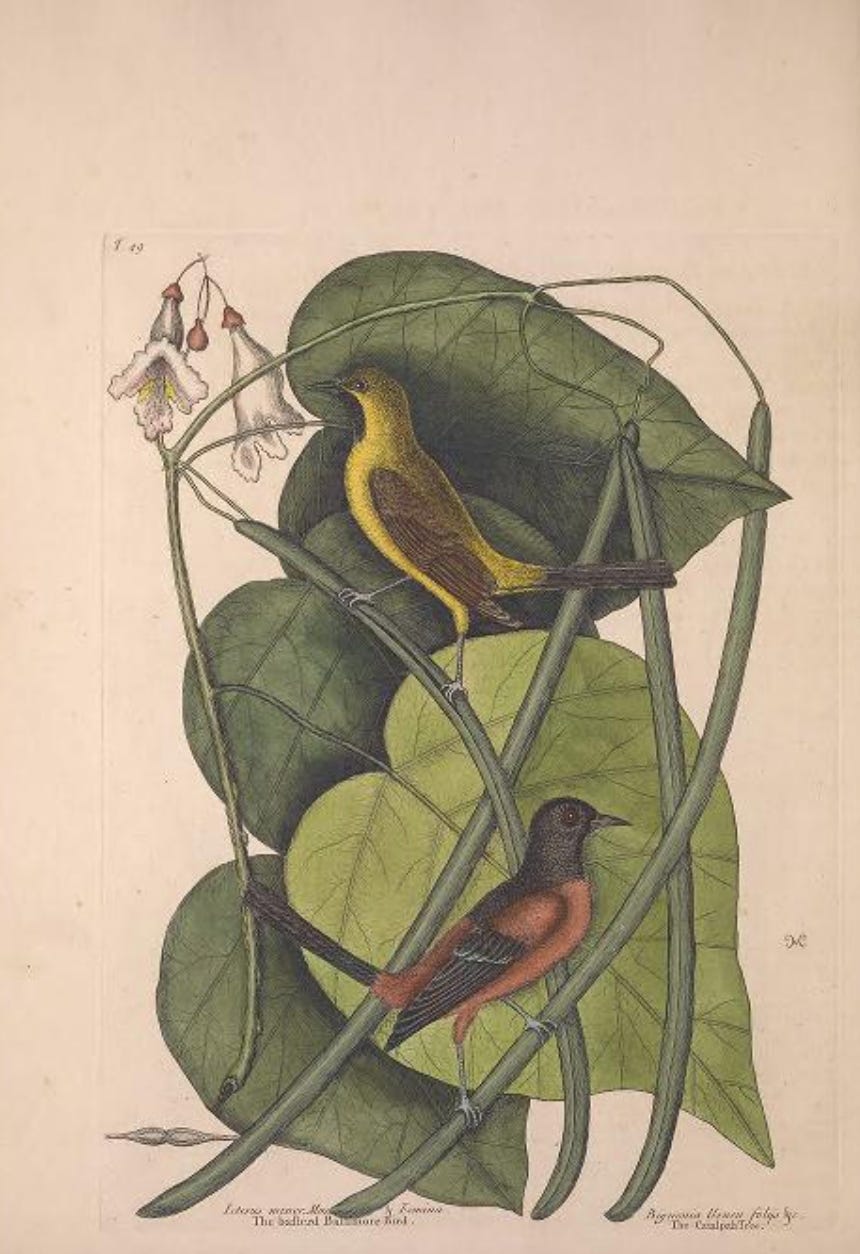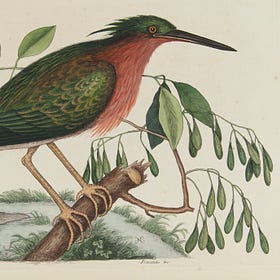The Baltimore B*stard
Paging through a first edition of Mark Catesby’s The Natural History of Carolina, Florida, and the Bahama Islands is a special experience. One can come in direct contact with a book that was essentially handmade by Catesby and captured the attention of the British monarchy. Europeans would have been astonished by the flora and fauna depicted in this work, including the first glimpses of many species like the Ivory-billed Woodpecker, a species with no equal in the Old World. The colors in this book are as bright and lively as they were 275 years ago.
As modern and groundbreaking as The Natural History was, there are references that appear dated from the 2025 perspective.
That brings us to the above page, which depicts the “b*sterd Baltimore bird” on the bottom. On a facing page, the descriptive text deems the bird as “The B*stard Baltimore.”1
I was a bit confounded by Catesby’s nomenclature. Thoughts of a particularly disagreeable member of the hapless 1987 Baltimore Orioles baseball team came to mind.
By all appearances, Catesby was depicting the handsome Orchard Oriole, a burnt-orange and black oriole that’s a bit more retiring than the Baltimore. But why call it a b*stard?
The Baltimore Oriole was already associated with Lord Baltimore and Maryland by Catesby’s time. That’s because Lord Baltimore’s family coat of arms, still seen in Maryland’s state flag to this day, included gold and black prominently.2
In exploring this further, this could only be a usage of “b*stard” that’s no longer en vogue. Merriam-Webster states that b*stard was used in a neutral fashion until the late 20th century. The best explanation specific to Catesby’s usage I could find was this one:
something that is spurious, irregular, inferior, or of questionable origin
Spurious may be the key word here. Here’s the definition of spurious:
outwardly similar or corresponding to something without having its genuine qualities : false
This would seem to make some sense, and, as I later learned, the species’ Latin name to this day is indeed Icterus spurius. It seems a direct reference to the name Catesby used, if not coined by the Englishman himself.
Some Orchard Orioles—females and immature birds—look a lot like Baltimore Orioles. They’re yellow-ish, with black in some places, and about the same size. Early natural scientists were observing birds in a time without binoculars or a camera. Their glimpses of field marks may have been quite fleeting.
So it likely wasn’t that Catesby had anything against the oriole. It was just a “false” one when compared with a Baltimore. It was more likely that this use of b*stard was to distinguish the Orchard Oriole from its more vibrantly colored relative.
If you enjoyed this post, leave a comment or press the like button. Every bit of engagement helps more people find my work and join the TWiB community.
Before Audubon, there was Catesby
Last week’s announcement that the Chicago Audubon Society was changing its name to Chicago Bird Alliance had me thinking about …
I am adding an asterisk to throw off Substack’s automated censorship systems.
This is also a bit confounding. The male Baltimore Oriole is bright orange and black. The female is more green-yellow, but not quite a tone that matches the Maryland flag.






Bob, I enjoyed this article that delves into the scientific nomenclature to help understand the very interesting common name used by Catesby! This reminds me of the many plant species that are called "False" - e.g. False Sunflower - because of their resemblance to the "true" species but with some critical diagnostic differences. It would make great sense for Catesby to compare the Orchard Oriole to the Baltimore Oriole in this way. Fun read!
You solved the mystery: spurius because it was mistaken for Baltimore oriole. Dawn breaks slowly over Marblehead.